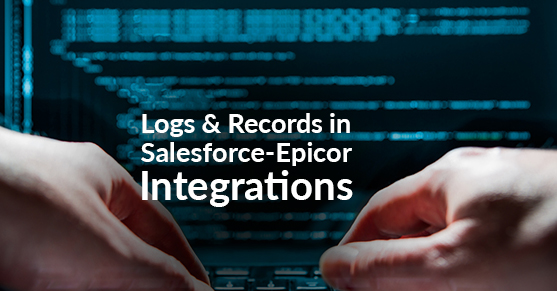In a previous blog on concurrency issues in Salesforce-Epicor integrations, we looked at handling round-robin updates in the integration and troubleshooting tactics. Along the same lines, there are some best practices your team can employ to gain detailed information on the overall health of your Salesforce-Epicor integration.
One of the most common headaches our clients deal with when they’re facing concurrency issues between Salesforce and Epicor is not having the information to find out “who did what” or “what did what.” Their CRM and ERP aren’t efficiently communicating, which puts a damper on the integration’s value and effectiveness. So, we’d like to give a brief overview of a few things that cannot be overlooked when managing this integration: Record-Keeping Logs, Transaction Records, and the advantages of readability.
Record-Keeping Log
Logs are incredibly vital for the Salesforce admin to review any information concerning a problem, and in the case of Salesforce-Epicor, we need to create a consolidated log. With a consolidated log, any error that goes from Salesforce or comes to Salesforce is collected in one readable log. And, the critical data that comes with this type of detailed logging, especially on the Salesforce side, is essential for reporting errors and designing their solutions. Readability is also crucial, as people who aren’t even familiar with Salesforce or tech-savvy need to be able to review the details, identify the problem, and convey that information to other team members, vendors, and administrators.
When your team gives priority to maintaining detailed record-keeping logs, your IT staff or third-party administrators will be able to provide solutions in a fraction of the time that it would’ve taken without them.
Transaction Records
In the case of finding out “who did what,” another great tool is the transaction record. When an admin gets notified about necessary changes, they don’t happen in real-time. When a change is necessary to maintain the system, it’ll be processed every five minutes. By using a transaction record in Salesforce, the integration application will retrieve the next records needing to be synced, grab the value and the mapping, and send it to Epicor (and, of course, vice versa). If the sync fails, the transaction will update the status to “failure,” and the updates will get reprocessed in the next cycle. Transaction records ensure that updates moving between Salesforce and Epicor will always be handled and tracked efficiently.
Non-Crossover Between Salesforce and Epicor Experts
In the end, the reason these logging practices are so vital is that they contribute to another prominent challenge with Salesforce and Epicor, which is simply the problem of non-crossover between admins. In other words, Epicor experts aren’t versed in Salesforce, and vice versa. However, this is why detailed and readable logging is so important. No matter what, if your team is integrating Salesforce and Epicor, information tracking and logs need to be understandable to the point that they can exchange the information without strenuous explanation, and the appropriate vendor can take care of their side of the fence.
Whether you’re working on the Salesforce side of the integration or the Epicor side, one of the best approaches you can take to smooth implementation is communication between administrators. With thorough record-keeping logs and transaction records, not only do you get strong communication, but you give your IT staff the ability to solve integration problems with little to no downtime. Ultimately, it waterfalls down into your sales and resource departments to provide them the information they need when they need it.
If you have any questions on how to optimize your Salesforce-Epicor integrations, feel free to ask in the comments below or reach out to us here.
This post was originally published here.

